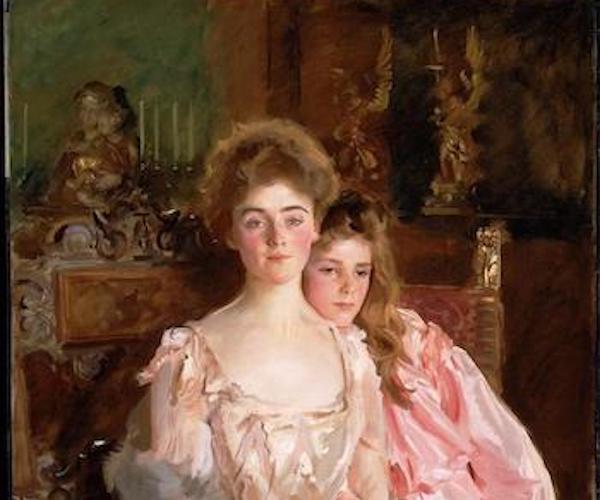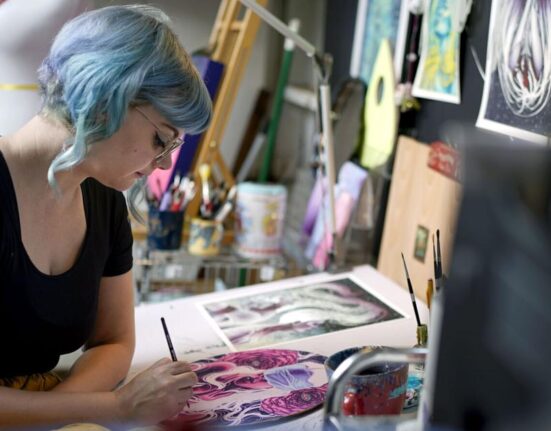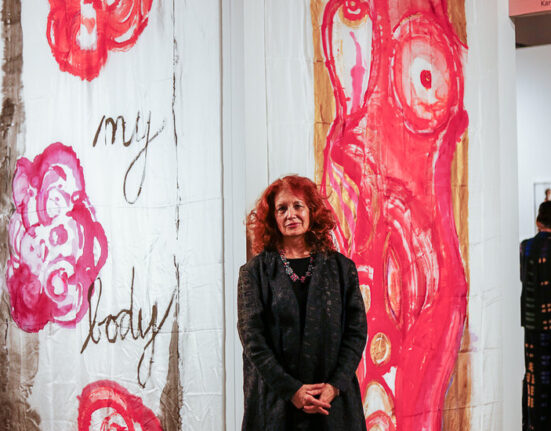By Kathleen Stone and Peter Walsh
Is the artist’s direction of clothing choices — and how he painted the garments — a sufficiently compelling inquiry in which to anchor an exhibit?
Two Art Fuse critics were interested in reviewing the same show— Fashioned by Sargent, currently at the Museum of the Fine Arts through January 15, 2024. In the past, the magazine has published more than one review of the same event, an experiment meant to relive the era when there were many newspapers in every large city and they all supported critics, leading to varied points of view of every concert, play, performance, or art exhibition.
This time we are trying something else, more like a conversation. We will post twice on the Sargent show. The post below features Kathleen Stone’s brief initial responses to the show, followed by a reaction by Peter Walsh before he has seen the exhibition. The second piece will feature Peter’s longer survey of and thoughts about the show followed by Kathleen’s longer response and summing up.
Readers, please feel free to add your voices to the dialogue and our critics will respond to you as well.
— Editor Bill Marx
Hi Peter,
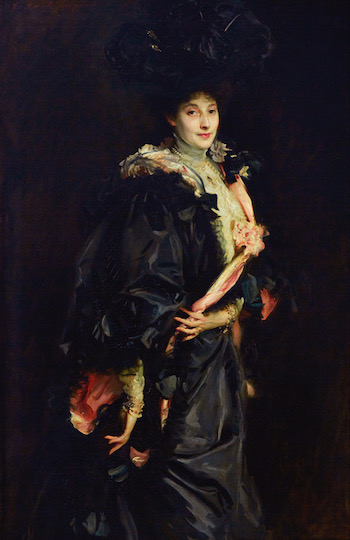
John Singer Sargent, “Lady Sassoon (Aline de Rothschild),” 1907. Photo: MFA
I’ve just been to the Sargent exhibit at the MFA and can’t wait to hear your thoughts, just as soon as you’ve had a chance to see it. For now, I’ll share some of my reactions.
If you like the work of John Singer Sargent, this is a chance to indulge. More than 50 paintings are collected here, together with some of the clothing, hats, and other accessories seen in his portraits. As a portrait painter, Sargent had a reputation for commandeering the process: telling the person what to wear, where to sit ,and how to pose, all to capture his vision of the person. Exploring that process, clothing choices in particular, is the animating idea behind Fashioned by Sargent. But is the artist’s direction of clothing choices — and how he painted the garments — a sufficiently compelling inquiry in which to anchor an exhibit? I look forward to discussing that question with you. Also, whether the exhibit fully explores the question.
The first portrait you see when entering the exhibit is stunning. It’s Lady Sassoon, born Aline de Rothschild, of London. She’s wearing a black taffeta opera coat, with salmon pink lining. The actual garment is displayed next to the painting, giving you an idea of how it might feel to move about in something so luxe, and inviting comparison to Sargent’s painted version which is slimmed down and draped to accentuate the glowing pink lining.
This is a relatively minor manipulation, but a small photograph illustrates that Sargent sometimes went to much greater lengths to stage a portrait. The photo, from 1903, shows him painting the portrait of Mrs. Fiske Warren and her daughter Rachel. Mother and daughter are perched on an uncomfortable chair in the middle of the Gothic Room of what is now the Isabella Stewart Gardner Museum. There is nothing homey or comfortable about the scene. Apparently, Mrs. Warren wore a borrowed pink gown that did not fit, and Rachel was draped in pink fabric that Sargent had to paint into a gown. But pink was the color Sargent thought would best compliment their coloring, and he must have thought the room’s details would provide an appropriately decorative background. In the finished portrait, Rachel rests her chin on her mother’s shoulder, their pink dresses plausibly sketched. The cold, open space of the Gothic Room is shrunk; you are invited to assume that they are comfortably at home.
As I moved through the rooms of portraits, I played a game with myself, imagining which of Sargent’s subjects I would like to meet in a neighborhood coffee shop. Silly as this sounds, it was a way of responding to the person presented on the canvas. Of course, clothing is part of the presentation, but I tried to focus on the face and the feeling that gave me. It turns out I would have liked to meet a number of Sargent’s subjects, including Lady Sassoon. And of course, I’m interested to hear how you respond to them.
— Kathleen Stone
Hi Kathleen,
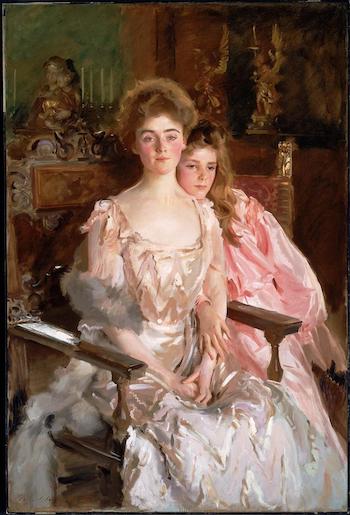
John Singer Sargent, Mrs. Fiske Warren (Gretchen Osgood) and Her Daughter Rachel, 1903. Photo: MFA
Thanks so much for your email. As you know, I haven’t seen the show yet and am responding from that point of view, having spent a fair amount of my book reviewing time recently with Sargent and Sargent’s circle in Boston, especially Isabella Stuart Gardner. To clue in our readers: we are engaged in a kind of duo review. After I actually see the show, I will write up my reactions and you will respond to those in a second posting (I’m giving you, I just realized, both the first and last words!)
In anticipation of this project, I have been thinking about the changeable weather of Sargent’s reputation and his rather peculiar influence on Boston’s art community well after his death. Sargent started out in 19th-century Paris as a youthful prodigy, known for his breathtaking technique and a certain raffish daring. He overstepped that fashionable edginess in one portrait to create a huge, unexpected scandal that almost ended his career and precipitated his move from Paris to London. Some fifty years later, though, he was considered impossibly old fashioned, stuffy, tame, and out of touch with the revolutionary art that emerged after 1900. That stodgy image stuck to him for most of the 20th century (except in Boston) until, in the last couple decades before the 21st, he made a spectacular come-back. Once again his work was hailed as racy, sumptuous, and, well, even sexy. He also attracted an enthusiastic band of youngish fans and was widely admired and beloved as never before.
One cultural issue that has emerged since the last round of major Sargent shows, though, is the ‘woke’ awareness of historic racial and class domination in the United States and Europe. Let’s face it, Sargent’s society portraits are just dripping with white privilege in its most blatant forms, just when European colonialism was at its peak. Sargent did make private watercolors of Bedouins in North Africa, but people of color are never the subject of his formal portraits in oil, even though one of Sargent’s most important models in Boston was a local African-American man (Sargent always portrayed him, in works intended for public consumption, as white). Will the new cultural attitudes eclipse Sargent’s reputation yet again? Will he be cancelled? So far I am seeing no signs of this. Does the MFA allude to the issue at all?
I was intrigued by your wish to meet some of Sargent’s more interesting-looking female subjects. One of them, Lady Aline Sassoon, whose impressive portrait you say opens the show, was, along with a number of Sargent’s British patrons, associated with the Souls, a clique of high-powered men and women devoted to the art-for-art’s-sake ideals of the Aesthetic Movement. The group also included Evan Charteris, who became Sargent’s first serious biographer. I suspect you would have found some interesting things to talk about.
Kathleen Stone is the author of They Called Us Girls: Stories of Female Ambition from Suffrage to Mad Men, an exploration of the lives and careers of women who defied narrow, gender-based expectations in the mid-20th century.
Peter Walsh has worked as a staff member or consultant to such museums as the Harvard Art Museums, the Museum of Fine Arts, Boston, the Davis Museum at Wellesley College, The Metropolitan Museum of Art, the National Gallery of Art, and the Boston Athenaeum. He has published in American and European newspapers, journals, and in scholarly anthologies and has lectured at MIT, in New York, Milan, London, Los Angeles and many other venues. In recent years, he began a career as an actor and has since worked on more than 100 projects, including theater, national television, and award-winning films. He is completing a novel set in the 1960s.

